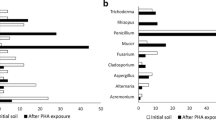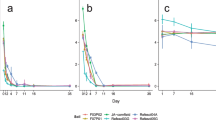Summary
Soil microorganisms from one site were shown to be consistently capable of the transformation of 1,6-dichloro-1,6-dideoxy-β,d-fructofuranosyl-4-chloro-4-deoxy-α,d-galactopyranoside (TGS) in laboratory batch cultures. With fresh soils, all of the available chloride ions were released from the molecule. Subcultures of a TGS-dehalogenating bacterial community produced a progressive decline in the dehalogenating capabilities towards the substrate. The soil organisms did not utilise TGS as a carbon source. The transformation was achieved by co-metabolism and was probably supported by an unknown component in the soil. Four bacterial species were isolated from the TGS-dehalogenating soil community: twoBacillus species, anAcinetobacter group isolate and aMicrococcus group isolate. Thin-layer chromatography confirmed the disappearance of the chlorosugar and high-performance liquid chromatography demonstrated that neither of the constituent monosaccharides—1,6-dichlorofructose nor 4-chlorogalactosucrose was accumulated as an intermediate.
Résumé
Les microorganismes du sol d'un certain endroit ont été démontrés être capable, sans exception, de la transformation de 1,6-dichloro-1,6-dideoxy-β,D-fructofuranosyl-4-chloro-4-deoxy-α,D-galactopyranoside (TGS) en cultures de laboratoire du type discontinu. Avec des prélèvements frais du sol, tous les ions disponibles de chlorure ont été libérés de la molécule. Des souscultures d'une communauté bactérienne capable de déhalogeniser le TGS ont produit un déclin progressif de la capacité de déhalogeniser le substrat. Les microorganismes du sol n'ont pas utilisé le TGS comme source de carbone. La transformation s'est accomplie par cometabolisme et, probablement, s'est basée sur un component indéterminé du sol. Quatre espèces bactériennes ont été isolées de la communauté de bactéries du sol capable de déhalogeniser le TGS: deux espèces deBacillus, unAcinetobacter et unMicrococcus. Des études de chromatographie de couches fines ont confirmées la disparition du chlorosaccharide, tandis que des études de chromatographie liquide de haut rendement ont démontrées que, des monosaccharides constituants, ni 1,6-dichlorofructose ni 4-chlorogalactosucrose, n'ont été accumulés comme produits intermédiaires.
Resumen
Microorganismos de suelo de cierto lugar demostraron consistemente ser capaces de realizar la transformación de 1,6-dicloro-1,6 dideoxi-β-D-fructofuranosil-4-cloro-4-deoxi-α,D-alactopiranosa (TGS) in culturas de laboratorio de tipo discontinuo. Con muestras frescas de suelo, todos los iones cloruro fueron liberados de la molecula. Subculturas de una comunidad bacterial capaz de dehalogenizar TGS produjeron una declinación progresiva de la capacidad de dehalogenizar el substrato. Los microorganismos no utilizaron el TGS como fuente de carbono. La transformación se realiza por co-metabolismo y probablemente se base en un componente del suelo, no determinado. Cuatro especies bacteriales fueron aisladas de la comunidad de bacterias de suelo con capacidad de dehalogenar el TGS: dos especies deBacilo, unaAcinelobacteria y unMicrococo. Estudios de cromatografía de capa delgada confirmaron la desaparición del clorosacárido, y estadios de cromatografía liquida demostraron que ninguno de los componentes monoscáridos — 1,6-diclorofructuosa y 4-clorogalactosucrosa — eran acumulados como productors intermedios.
Similar content being viewed by others
References
Alexander, M. &Aleem, M.I.H. 1961. Effect of chemical structure on microbial decomposition of aromatic herbicides.Journal of Agricultural and Food Chemistry 9, 44–47.
Anderson, A.C. 1986. Environmental toxicology—biodegradation of xenobiotics.Journal of Environmental Health 48, 196–199.
Bull, A.T. 1980 Biodegradation: some attitudes and strategies of microorganisms and microbiologists. InContemporary Microbial Ecology, ed. Ellwood, D.C. et al. pp. 107–136. London: Academic Press.
Harder, W. 1981 Enrichment and characterisation of degrading organisms. InMicrobial Degradation of Xenobiotic and Recalcitrant Compounds, ed. Leisinger, T., Cook, A. M., Hütter, R. & Nuesch, J. pp. 77–96. London: Academic Press.
Hough, L. &Phadis, S.P. 1976 Enhancement in the sweetness of sucrose.Nature 263, 800.
Hough, L. &Khan, R. 1978 Intensification of sweetness.Trends in Biochemical Sciences 3, 61–63.
Hough, L. 1985 The sweeter side of chemistry.Chemical Society Reviews 14, 357–374.
Karasevich, Y.N. &Zaitsev, G.M. 1984 Utilization of 4-chlorobenzoic acid and 2,4-dichlorobenzoic acids by a mixed culture of microorganisms.Microbiology 53, 290–296.
Kier, L.B. 1980 Molecular structure influencing either a sweet or bitter taste among aldoximes.Journal of Pharmaceutical Science 69, 416–419.
Schmidt, E., Bartels, I. &Knackmuss, H-J. 1985 Degradation of 3-chlorobenzoate by benzoate or 3-methlbenzoate utilizing cultures.FEMS Microbial Ecology 31, 381–389.
Shallenberger, R.S. &Acree, T.E. 1967 Molecular theory of sweet taste.Nature 216, 480–482.
Slater, J.H., Lovatt, D., Weightman, A.J., Senior, E. &Bull, A.T. 1979 The growth ofPseudomonas putida on chlorinated aliphatic acids and its dehalogenase activity.Journal of General Microbiology 114, 125–136.
Stirling, I. &Dalton, H. 1979 The fortuitous oxidation and cometabolism of various carbon compounds by whole-cell suspensions ofMethylococcus capsulatus (Bath).FEMS Microbiology Letters 5, 315–318.
Author information
Authors and Affiliations
Rights and permissions
About this article
Cite this article
Lappin-Scott, H.M., Holt, G. & Bull, A.T. Microbial transformation of 1,6-dichloro-1,6-dideoxy-β,D-fructofuranosyl-4-chloro-4-deoxy-α,D-galactopyranoside (TGS) by soil populations. Mircen Journal 3, 95–102 (1987). https://doi.org/10.1007/BF00933609
Received:
Accepted:
Issue Date:
DOI: https://doi.org/10.1007/BF00933609




